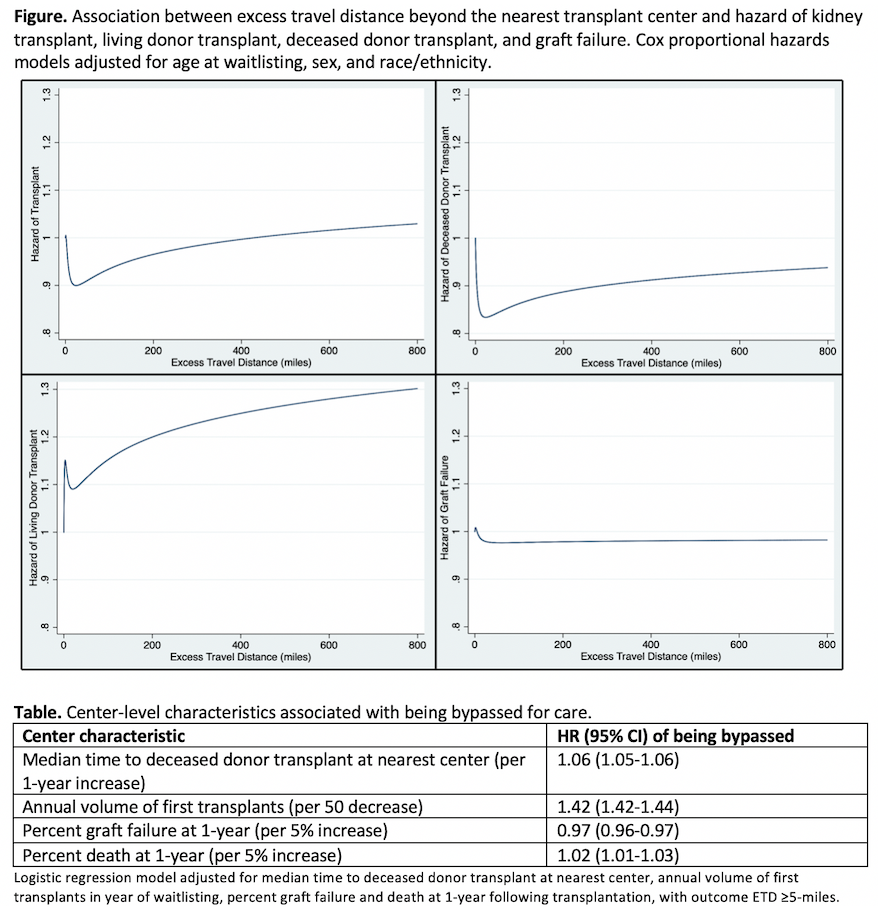Bypassing the Nearest Transplant Center for Care is Associated with Gains in Time to Living Donor but Not Deceased Donor Kidney Transplantation or Improved Graft Outcomes
1Division of Nephrology, University of California San Francisco (UCSF), San Francisco, CA, 2Department of Epidemiology and Biostatistics, UCSF, San Francisco, CA
Meeting: 2020 American Transplant Congress
Abstract number: A-247
Keywords: Graft failure, Kidney transplantation, Outcome, Waiting lists
Session Information
Session Name: Poster Session A: Non-Organ Specific: Disparities to Outcome and Access to Healthcare
Session Type: Poster Session
Date: Saturday, May 30, 2020
Session Time: 3:15pm-4:00pm
 Presentation Time: 3:30pm-4:00pm
Presentation Time: 3:30pm-4:00pm
Location: Virtual
*Purpose: Some patients may gain an advantage if they choose to bypass their local transplant center and receive care at a center further away but with more favorable wait time or other characteristics. This could contribute to disparities in kidney transplantation, as not all patients may have the means to travel to centers located further from their residence. Our objective was to determine if there was an association between bypassing the nearest transplant center for care and time to transplantation or graft failure. We also aimed to determine center-level characteristics that were associated with bypassing the nearest center for transplant care.
*Methods: We included adults who were waitlisted for their first kidney between 1995-2015 using the US Renal Data System. We used excess travel distance (ETD, defined as the additional distance that a patient travels to their transplant center beyond the distance to their nearest transplant center) as the predictor, modeled as a cubic spline. Our outcomes were time to deceased or living donor transplantation (primary), and time to graft failure (secondary) among those who received an organ. We used adjusted proportional hazards models for analyses. We used logistic regression to evaluate center-level factors associated with being bypassed for care.
*Results: 379,545 patients were waitlisted during the study period and had valid zip code data for their residence and transplant center. Median age was 52.9 years. 36.5% had an ETD ≥5-miles. ETD was associated with higher hazard of living donor transplantation but with a lower hazard of deceased donor transplantation (figure). ETD was not statistically significantly associated with hazard of graft failure (figure). Of the center-level factors assessed, patients were most likely to bypass their nearest transplant center if the median waiting time for deceased donor transplant was longer (odds ratio 1.06 per 1-year increase, 95% CI 1.05-1.06, table) and the volume of transplant surgeries per year was lower (odds ratio 1.43 per 50 less first transplants per year, 95% CI 1.42-1.44, table).
*Conclusions: Patients who bypass their nearest center for care have better access to living but not deceased donor transplantation, and no difference in graft survival. Patients were more likely to bypass centers with longer waiting times and lower transplant volumes. Further studies are needed to understand these observations and ensure equity in organ access and outcomes.
To cite this abstract in AMA style:
Whelan AM, McCulloch C, Ku E. Bypassing the Nearest Transplant Center for Care is Associated with Gains in Time to Living Donor but Not Deceased Donor Kidney Transplantation or Improved Graft Outcomes [abstract]. Am J Transplant. 2020; 20 (suppl 3). https://atcmeetingabstracts.com/abstract/bypassing-the-nearest-transplant-center-for-care-is-associated-with-gains-in-time-to-living-donor-but-not-deceased-donor-kidney-transplantation-or-improved-graft-outcomes/. Accessed January 1, 2026.« Back to 2020 American Transplant Congress

